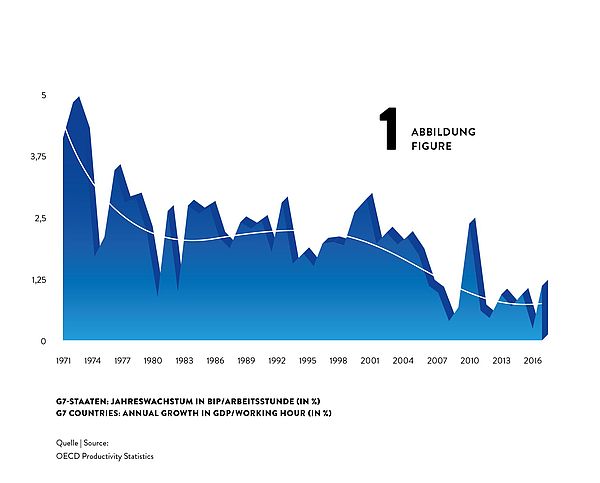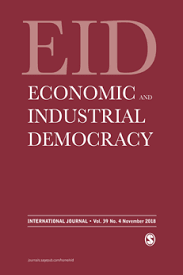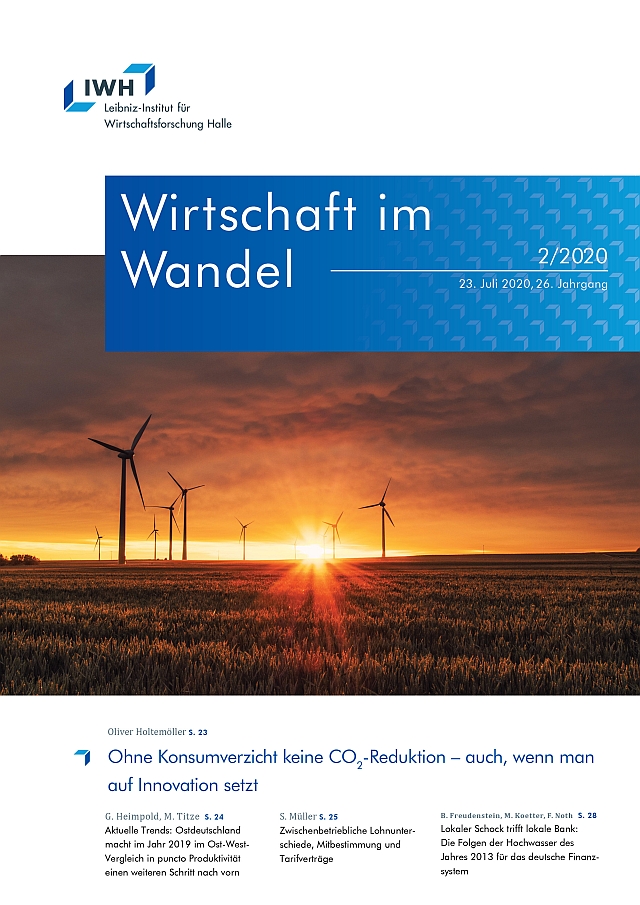Productivity: More with Less by Better
Available resources are scarce. To sustain our society's income and living standards in a world with ecological and demographic change, we need to make smarter use of them.
Dossier

In a nutshell
Nobel Prize winners Paul Samuelson and William Nordhaus state in their classic economics textbook: Economics matters because resources are scarce. Indeed, productivity research is at the very heart of economics as it describes the efficiency with which these scarce resources are transformed into goods and services and, hence, into social wealth. If the consumption of resources is to be reduced, e. g., due to ecological reasons, our society’s present material living standards can only be maintained by productivity growth. The aging of our society and the induced scarcity of labour is a major future challenge. Without productivity growth a solution is hard to imagine. To understand the processes triggering productivity growth, a look at micro data on the level of individual firms or establishments is indispensable.
Our experts

Department Head
If you have any further questions please contact me.
+49 345 7753-708 Request per E-Mail
President
If you have any further questions please contact me.
+49 345 7753-700 Request per E-MailAll experts, press releases, publications and events on “Productivity”
Productivity is output in relation to input. While the concept of total factor productivity describes how efficiently labour, machinery, and all combined inputs are used, labour productivity describes value added (Gross Domestic Product, GDP) per worker and measures, in a macroeconomic sense, income per worker.
Productivity Growth on the Slowdown
Surprisingly, despite of massive use of technology and rushing digitisation, advances in productivity have been slowing down during the last decades. Labour productivity growth used to be much higher in the 1960s and 1970s than it is now. For the G7 countries, for example, annual growth rates of GDP per hour worked declined from about 4% in the early 1970s to about 2% in the 1980s and 1990s and then even fell to about 1% after 2010 (see figure 1).

This implies a dramatic loss in potential income: Would the 4% productivity growth have been sustained over the four and a half decades from 1972 to 2017, G7 countries’ GDP per hour would now be unimaginable 2.5 times as high as it actually is. What a potential to, for instance, reduce poverty or to fund research on fundamentals topics as curing cancer or using fusion power!
So why has productivity growth declined dramatically although at the same time we see, for instance, a boom in new digital technologies that can be expected to increase productivity growth? For sure, part of the decline might be spurious and caused by mismeasurement of the contributions of digital technologies. For instance, it is inherently difficult to measure the value of a google search or another video on youtube. That being said, most observers agree that part of the slowdown is real.
Techno-Pessimists and Techno-Optimists
Techno-pessimists say, well, these new technologies are just not as consequential for productivity as, for instance, electrification or combustion engines have been. Techno-optimists argue that it can take many years until productivity effects of new technologies kick in, and it can come in multiple waves. New technology we have now may just be the tools to invent even more consequential innovations in the future.
While this strand of the discussion is concerned with the type of technology invented, others see the problem in that inventions nowadays may diffuse slowly from technological leaders to laggards creating a wedge between few superstar firms and the crowd (Akcigit et al., 2021). Increased market concentration and market power by superstar firms may reduce competitive pressure and the incentives to innovate.
Finally, reduced Schumpeterian business dynamism, i.e. a reduction in firm entry and exit as well as firm growth and decline, reflects a slowdown in the speed with which production factors are recombined to find their most productive match.
While the explanation for and the way out of the productivity puzzle are still unknown, it seems understood that using granular firm level data is the most promising path to find answers.
What are the Origins of Productivity Growth?
Aggregate productivity growth can originate from (i) a more efficient use of available inputs at the firm level as described above or (ii) from an improved allocation of resources between firms.
Higher efficiency at the firm level captures, e.g., the impact of innovations (Acemoglu et al., 2018) or improved firm organisation (management) (Heinz et al., 2020; Müller und Stegmaier, 2017), while improved factor allocation describes the degree of which scarce input factors are re-allocated from inefficient to efficient firms (‘Schumpeterian creative destruction’) (Aghion et al., 2015; Decker et al., 2021).
Most economic processes influence the productivity of existing firms and the growth and the use of resources of these firms and their competitors as well. The accelerated implementation of robotics in German plants (Deng et al., 2020), the foreign trade shocks induced by the rise of the Chinese economy (Bräuer et al., 2019), but also the COVID-19 pandemic, whose consequences are still to evaluate (Müller, 2021) not only effects on productivity and growth of the firms directly affected but at the same time may create new businesses and question existing firms.
While productivity can be measured at the level of aggregated sectors or economies, micro data on the level of individual firms or establishments are indispensable to study firm organisation, technology and innovation diffusion, superstar firms, market power, factor allocation and Schumpeterian business dynamism. The IWH adopts this micro approach within the EU Horizon 2020 project MICROPROD as well as with the CompNet research network.
As “creative destruction” may also negatively affect the persons involved (e. g., in the case of layoffs, Fackler et al., 2021), the IWH analyses the consequences of bankruptcies in its Bankruptcy Research Unit and looks at the implications of creative destruction for the society, e. g., within a project funded by Volkswagen Foundation searching for the economic origins of populism and in the framework of the Institute for Research on Social Cohesion.
Publications on “Productivity”

Why Is there Resistance to Works Councils In Germany? An Economic Perspective
in: Economic and Industrial Democracy, No. 3, 2020
Abstract
Recent empirical research generally finds evidence of positive economic effects for works councils, for example with regard to productivity and – with some limitations – to profits. This makes it necessary to explain why employers’ associations have reservations about works councils. On the basis of an in-depth literature analysis, this article shows that beyond the generally positive findings, there are important heterogeneities in the impact of works councils. The authors argue that those groups of employers that tend to benefit little from employee participation in terms of productivity and profits may well be important enough to shape the agenda of their employers’ organization and have even gained in importance within their organizations in recent years. The authors also discuss the role of deviations from profit-maximizing behavior like risk aversion, short-term profit-maximization and other non-pecuniary motives, as possible reasons for employer resistance.

Kommentar: Ohne Konsumverzicht keine CO2-Reduktion – auch, wenn man auf Innovation setzt
in: Wirtschaft im Wandel, No. 2, 2020
Abstract
In der Diskussion über die deutsche Klimapolitik steht häufig die Frage im Mittelpunkt, mit welchen Instrumenten sich eine Reduktion der CO<sub>2</sub>-Emissionen am wirksamsten erreichen lässt. So werden etwa die Vorund Nachteile von CO<sub>2</sub>-Steuern im Vergleich zur Versteigerung von CO<sub>2</sub>-Zertifikaten und die Reihenfolge der Abschaltung von Braunkohlekraftwerken diskutiert. Neben diesen eher mikroökonomischen Aspekten hat die Klimapolitik weitreichende makroökonomische Konsequenzen.

Aktuelle Trends: Ostdeutschland macht im Jahr 2019 im Ost-West-Vergleich in puncto Produktivität einen weiteren Schritt nach vorn
in: Wirtschaft im Wandel, No. 2, 2020
Abstract
Ostdeutschland konnte laut Daten des Arbeitskreises „Volkswirtschaftliche Gesamtrechnungen der Länder“, die Ende März 2020 veröffentlicht wurden, im Jahr 2019 in puncto Produktivität im Vergleich zu Westdeutschland einen weiteren Schritt nach vorn gehen.

Ostdeutschland - Eine Bilanz
in: One-off Publications, Festschrift für Gerhard Heimpold, IWH 2020
Abstract
Anlass dieser Festschrift ist die Verabschiedung von Dr. Gerhard Heimpold, dem stellvertretenden Leiter der Abteilung Strukturwandel und Produktivität am Leibniz-Institut für Wirtschaftsforschung Halle (IWH), aus dem aktiven Berufsleben in den wohlverdienten Ruhestand. Gerhard Heimpold forschte am IWH zu Aspekten der Regionalentwicklung Ostdeutschlands unter Beachtung des politischen und wirtschaftlichen Transformationsprozesses. Er gehört heute zu den wenigen Experten in Deutschland, die umfassende ökonomische Kenntnis über den gesamten Verlauf des Transformationsprozesses der ostdeutschen Wirtschaft seit Mitte der 1980er Jahre vorweisen können. Gerhard Heimpold hat im Laufe seiner akademischen Ausbildung und seiner ersten wissenschaftlichen Tätigkeit tiefe Einblicke in die Ausgestaltung und Funktionsweise der sozialistischen Planwirtschaft der DDR erhalten und konnte dieses Wissen nach dem Mauerfall 1989 in wichtige wissenschaftliche Beiträge auf dem Gebiet der internationalen Transformationsforschung einbringen.

Der Produktivitätsrückstand der ostdeutschen Industrie: Nur eine Frage der Preise?
in: Contribution to IWH Volume, Festschrift für Gerhard Heimpold, IWH 2020
Abstract
Die volkswirtschaftliche Gesamtrechnung zeigt auch knapp drei Jahrzehnte nach der Deutschen Einheit, dass die Arbeitsproduktivität in Ostdeutschlands Industrie mehr als 20% unter dem westdeutschen Niveau verharrt. In dieser Arbeit gehe ich der Frage nach, ob dieser Rückstand die Folge einer geringeren physischen Produktivität oder niedrigerer Preise für ostdeutsche Erzeugnisse ist. Dazu werden Mikrodaten auf Firmenebene benutzt, die Informationen zu produzierten Gütermengen und erzielten Preisen enthalten. Der Rückstand in der Erlösproduktivität wird auch mit diesen Daten bestätigt. Die Hauptergebnisse sind, dass i) ostdeutsche Industrieunternehmen tatsächlich deutlich geringere Marktpreise erlösen und ii) der physische Output bei gleichen Inputmengen im Osten höher liegt als im Westen. Eine naheliegende Erklärung für beide Befunde ist, dass ostdeutsche Produkte weniger Kundennutzen generieren und gleichzeitig in weniger aufwändigen Produktionsverfahren hergestellt werden können. Weitere Tests zeigen, dass iii) die Hypothese verlängerter Werkbänke keine Erklärung für den ostdeutschen Produktivitätsrückstand ist und iv) ostdeutsche Betriebe im Vergleich zur westdeutschen Konkurrenz eine geringere physische Produktivität aufweisen, wenn sie Güter zu westdeutschen Preisen herstellen.



